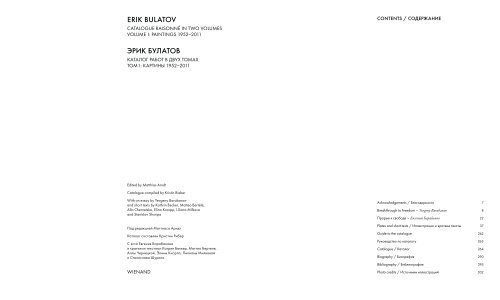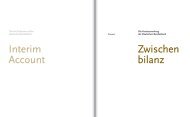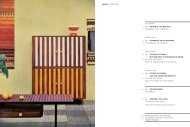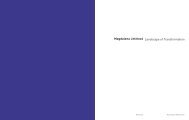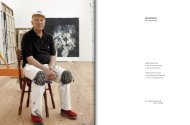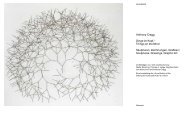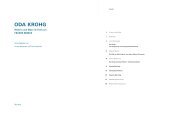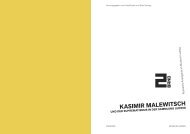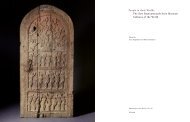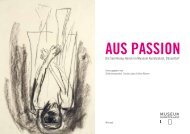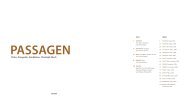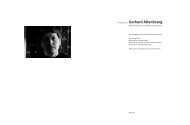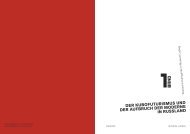ERIK BULATOV ſŲŪŬ ţŵŭŢŴŰŤ
ERIK BULATOV ſŲŪŬ ţŵŭŢŴŰŤ
ERIK BULATOV ſŲŪŬ ţŵŭŢŴŰŤ
You also want an ePaper? Increase the reach of your titles
YUMPU automatically turns print PDFs into web optimized ePapers that Google loves.
<strong>ERIK</strong> <strong>BULATOV</strong><br />
CATALOGUE RAISONNÉ IN TWO VOLUMES<br />
VOLUME I� �AINTINGS ���������<br />
���� �������<br />
������� ����� � ���� �����<br />
��� I� ������� ���������<br />
Edited by Matthias Arndt<br />
Catalogue compiled by Kristin Rieber<br />
With an essay by Yevgeny Barabanov<br />
and short texts by Kathrin Becker, Matteo Bertelé,<br />
Alla Chernetska, Elina Knorpp, Liliana Milkova<br />
and Stanislav Shuripa<br />
��� ��������� �������� �����<br />
������� ��������� ������� �����<br />
� ���� ������� ����������<br />
� ��a����� �������� ������ ������, ������ �������,<br />
���� ���������, ����� ������, ������� ��������<br />
� ���������� ������<br />
WIENAND<br />
�O�TE�T� � ����������<br />
Ackno�ledgements � ������������� 7<br />
Breakthrough to Freedom – Yevgeny Barabanov 8<br />
������ � ������� – Евгений Барабанов 22<br />
�lates and short texts � ����������� � ������� ������ 37<br />
Guide to the catalogue 262<br />
����������� �� �������� 263<br />
Catalogue � ������� 264<br />
Biography � ��������� 2��<br />
Bibliography � ������������ 295<br />
�hoto credits � ��������� ����������� 3�2
8<br />
BREAKTHROUGH TO FREEDOM<br />
Yevgeny Barabanov<br />
freedom is<br />
freedom is<br />
freedom is<br />
freedom is<br />
freedom is<br />
freedom is<br />
freedom is freedom<br />
Vsevolod Nekrasov<br />
Erik Bulatov is a central figure in Russian contemporary art. The reassessment<br />
of the tasks of painting he undertook half a century ago<br />
led him, along with other enthusiasts who followed in his wake, to a<br />
new view of the artistic profession, modernity, and art itself. Although<br />
the epithet “classic” is now attached to his name, the ultimate significance<br />
of this reassessment itself, as embodied in Bulatov’s artistic and<br />
theoretical legacy, has not yet been exhaustively interpreted by researchers.<br />
One thing is irrefutable: with his original art, Bulatov has<br />
accomplished the impossible. He took up the challenge of the Soviet<br />
modernity he was confronted with and, without hiding from it, without<br />
turning away from the totality of its indoctrination, opened doors<br />
into a world of freedom, into a world that enabled him to link art’s past<br />
with its future.<br />
It has been at the crossroads of the classical past, the avant-garde,<br />
ideological kitsch, and innovation that the problematics of Bulatov’s<br />
art – the problematics of the picture – has been tested.<br />
The question of the picture remains suspended in today’s critical<br />
consciousness. For some critics and artists, the picture is a commercial<br />
product that has outlived its age. For others, it is an arbitrary object just<br />
as arbitrarily dubbed “picture.” For still others, it is an occasion for simulative<br />
practices. For Bulatov, however, the picture continues to be part<br />
of a basic experience of trust in the world, with all the existential, ontological,<br />
cultural, and anthropological implications that follow from<br />
that trust. For Bulatov, the picture is a foothold, an opportunity for<br />
encounter, dialogue, recognition, understanding, and self-knowledge.<br />
The absence of naïveté in this stance, a naïveté that from the<br />
outset has been deflected by a consistent theoretical self-consciousness,<br />
has often moved Russian critics to detect in Bulatov’s work<br />
“ludic strategies” combining the techniques of, say, photorealism<br />
with the constructivist poster or mass media production. Moreover,<br />
the thematics of his pictures and the presence therein of elements of<br />
Soviet propaganda have long been interpreted in terms of Sots Art. 1<br />
Hence, Bulatov has been ranked both among the modernists and the<br />
postmodernists. 2<br />
Here we should immediately note that what Erik Bulatov was<br />
the first to undertake on the eve of the 1970s was of course not Sots<br />
Art, neither in the sense that it acquired in the subsequent ventures<br />
of Komar and Melamid, nor in the sense of a combinatory polystylistics,<br />
a masquerade-like doubling that employs fictional “artists”<br />
as its “characters” (a program absent in Bulatov’s work), nor in the<br />
sense of a Bakhtinian “carnivalization,” that is, a grassroots culture of<br />
folkloric jokes made at the expense of ideological symbols. In Bulatov’s<br />
work, the social dimension is represented in all seriousness: he does<br />
not employ an alien idiom to mock it. There is no irony in his work;<br />
irony is replaced by distance, by a viewpoint that enables him to see<br />
and recognize things, to give them names and images. Bulatov is not<br />
an eclecticist, and therefore his work is bereft of postmodernist pastiche,<br />
simulacra, and imitations of classicism. For him, the picture is<br />
an opportunity to defend the reality of art on the frontier between life<br />
and its devastation.<br />
The seriousness with which Bulatov has taken the theoretical<br />
bases of his stance has encouraged attempts to rank him among the<br />
conceptualists. 3 If what is meant here is concept art, then he makes<br />
no attempt to situate his art “after philosophy,” that is, after the philosophy<br />
of art, after the aesthetics of the painting, as Joseph Kosuth<br />
called on artists to do. Bulatov has never tried to replace the traditional<br />
image with its technical counterpart, to replace the colored pencil<br />
or paint brush with extra-pictorial realia – with texts, photographs,<br />
objects or actions. On the contrary, he has consistently defended the<br />
value and relevance of the picture. He has done much to overcome the<br />
aestheticism and aestheticization of “French painting,” but he considers<br />
the denial of aesthetics itself naive. 4<br />
It is obvious that instead of the empty and, in our case, meaningless,<br />
one-size-fits-all word “conceptualism,” it would be more correct<br />
to speak of conceptualization – that is, of the construction of particular<br />
models of pictorial space vis-à-vis the picture as thing and the perceptual<br />
experience of the picture’s artistic world. This perhaps sounds<br />
a bit old-fashioned, but it brings us noticeably closer to the essence of<br />
the matter, to the intentions, tasks, and problems that Bulatov himself<br />
is concerned with.<br />
1 See Margarita Tupitsyn, “Sots Art: The Russian Deconstructive Force,” in Margarita<br />
Tupitsyn, et al., Sots Art, exh. cat. New Museum of Contemporary Art, New York, et al.<br />
(New York, 1986), pp. 4–15 [on Bulatov pp. 7–8, 106]. The characterization of Bulatov<br />
as Sots Artist can also be found in concise form: “Erik Bulatov is today considered a leading<br />
representative of the so-called ‘Sots-art.’” Eric A. Peschler, Ateliers de Moscou: Dessins<br />
contemporains (Paris: Enrico Navarra – Galerie de France, 1989), p. 37.<br />
2 Е. Andreeva, Postmodernizm. Iskusstvo vtoroi poloviny XX–nachala XXI veka (Saint<br />
Petersburg: Azbuka-Klassika, 2007), pp. 210–211.<br />
3 “Bulatov is one of the key names in Moscow conceptualism.” I. Kulik, “Govorit i pokazyvaet<br />
Erik Bulatov. Retrospektiva zhivopistsa-nonkonformista v Tret’iakove,” Kommersant,<br />
September 21, 2006, p. 13.<br />
4 V. Tupitsyn, “Erik Bulatov,” in V. Tupitsyn, “Drugoe” iskusstvo. Besedy c khudozhnikami,<br />
kritikami, filosofami: 1980–1995 gg. (Moscow: Ad Marginem, 1997), pp. 66–67.<br />
We should remember that we are dealing with a wholly original,<br />
tremendously important artist who has achieved a supreme level<br />
of artistic maturity, definition, perfection, and formal precision. In<br />
Bulatov’s work, there is none of the coyness, ambiguity, pretentious<br />
striving after literary effects or mystical fogginess that in contemporary<br />
art so often conceals an ambitious incompetence. On the contrary,<br />
Bulatov is an artist capable of formulating general problems<br />
and articulating his own tasks with utter clarity and responsibility.<br />
The same can be said of his system of self-interpretation, which is<br />
least of all a makeweight to the work itself. Its function is to limit all<br />
forms of indeterminacy, and that is why it is directed both towards<br />
integration and differentiation. And because any form of integration<br />
consists of differentiations, Bulatov is particularly attentive to the latter.<br />
Moreover, the system of differences he has introduced encompasses<br />
not only the specifics of the works themselves, but also the premises<br />
and rules of their hermeneutics, which are generated in dialogue with<br />
the picture, with tradition, with the viewer. The agency of the viewer<br />
is particularly important: Bulatov’s system of unities and differences is<br />
an open system albeit one that seems, to some, paradoxical; however,<br />
it excludes all ambivalence. Hence, the desire to reduce indeterminacy<br />
also gives rise to more basic distinctions signaled to the outside world,<br />
to those negative self-definitions on which Bulatov never tires of insisting:<br />
that his work is not modernism, not Sots Art, not hyper- (or<br />
photo-) realism, not mass media.<br />
We should begin our brief resume of Bulatov’s life with this elucidatory<br />
“not.”<br />
1. MOSCOW – PARIS<br />
Bulatov is not from the Urals. Although he was born in Sverdlovsk<br />
(now known as Yekaterinburg) in 1933, his parents were Muscovites.<br />
After his father returned to the capital from an assignment in<br />
Sverdlovsk, Bulatov grew up, studied, and then worked in Moscow<br />
right up until his emigration from the Soviet Union in the late 1980s.<br />
From 1947 to 1952, he studied at the Moscow Arts Middle School<br />
(MSKhSh) and after graduation in the painting department at the<br />
Surikov Art Institute in Moscow. These educational institutions remained<br />
the most prestigious strongholds of Soviet academic art right<br />
up until the fall of communism.<br />
However, the decisive role in Bulatov’s formation as an artist was<br />
played by two men – the painter Robert Falk (1886–1958), whom<br />
Bulatov met in 1952, and Vladimir Favorsky (1886–1964), a graphic<br />
artist, master book illustrator, original thinker, and art theorist whom<br />
Bulatov met in 1956.<br />
Both Falk and Favorsky emerged as artists during the avant-garde<br />
period. Later, during the 1920s, both men taught at the renowned<br />
Vkhutemas/Vkhutein in Moscow. Finally, both were denounced as<br />
“formalists” by semi-official doctrinaires and shunted to the sidelines<br />
of artistic life. Recognition of their significance, role, scale, and<br />
indisputable achievements in Russian art came only gradually, with<br />
the advent of the Khrushchev Thaw. Both Falk and Favorsky formed<br />
original artistic systems based on a profound knowledge of the latest<br />
tendencies in European art, as well as a critical reassessment of them.<br />
Favorsky studied in Munich in 1906–1907 and, later, in the art history<br />
department of Moscow University; he translated the theoretical<br />
texts of the sculptor Adolf Hildebrand as well as Karl Voll’s book<br />
Comparative Studies of Paintings. 5 Falk, an adherent of Cézanne and<br />
the Cubists, was a member of the Jack of Diamonds group. Later,<br />
from 1928 to 1937, he lived and worked in Paris, where he had been<br />
sent originally (for a much shorter term) to study “classical art.” This,<br />
however, did not prevent him from becoming intimately familiar<br />
with all the significant phenomena in the artistic life of this period.<br />
Falk’s conversations with the student Bulatov, and their viewing<br />
and critique of work (this all began while Stalin was still alive!) were<br />
a defining moment for Bulatov. “I essentially got my understanding<br />
of French art (and all French culture in general) from Falk. But perhaps<br />
what was more important was that Falk became for me an exemplar<br />
of how the artist should conduct himself in social space. He<br />
had no opportunity to exhibit his works, and as an artist he lived in<br />
total isolation. Official critics pretended that there was no such artist.<br />
And without fuss, without becoming indignant, without trying<br />
to adapt, not reacting to anything, he went on with his work, peaceful<br />
and focused. I think that Falk was the only member of his generation<br />
of artists who not only did not regress during those years, but, on the<br />
contrary, worked better than he previously had.” 6<br />
Bulatov continued to master Falk’s painterly principles and, occasionally,<br />
up until 1961, to imitate his manner. Thereafter, and right<br />
up to the present day, the place of the teacher in Bulatov’s life has been<br />
occupied by Vladimir Favorsky. For Bulatov, it was no longer a matter<br />
of overcoming the deadening academicism of socialist realist painting<br />
as much as it was a matter of developing his own problematics, his own<br />
artistic system.<br />
Bulatov did not imitate Favorsky, nor did he even show him his<br />
works. Instead he would go to the patriarch of Moscow art to ask questions.<br />
The master’s answers, which were grounded in his own artistic<br />
practices, a profound analysis of the spatiality of artworks, and, finally,<br />
his rich experience as a teacher, introduced Bulatov not so much to<br />
readymade solutions as to methodological self-consciousness, to a clear<br />
sense of one’s own work and the how, what, and why of the work done<br />
by others. Under Favorsky’s tutelage, Bulatov mastered and rethought<br />
principles, not techniques.<br />
Bulatov’s encounter with Falk and Favorsky marked the beginning<br />
of a thoroughgoing process of re-education – a conscious overcoming<br />
of the doctrines and methods of socialist realist painting. Along with<br />
this re-education, Bulatov formulated his own problematics as an artist:<br />
the problematics of the picture as a multi-dimensional spatial universe.<br />
This was least of all a quest for formal solutions. The question of<br />
the picture – its potential, place, and role in art – became the content<br />
of Bulatov’s life, a means of self-understanding, a way to reflect on existential,<br />
metaphysical, and social questions. It goes without saying that<br />
this interpretation of the picture and his own mission in life inevitably<br />
distanced him from a successful career as a Soviet painter.<br />
5 A. Gil’debrand, Problema formy v izobrazitel’nom iskusstve, trans. N. B. Rozenfel’d and<br />
V. A. Favorskii (Moscow: Musaget, 1914) [Russian translation of Adolf Hildebrand,<br />
Das Problem der Form in der Bildenden Kunst (Straßburg: Heitz, 1901)]; K. Foll’, Opyt<br />
sravnitel’nogo izucheniia kartin, trans. N. B. Rozenfel’d and V. A. Favorskii (Moscow:<br />
Izdatel’stvo G. A. Lemana i S. I. Sakhorova, 1916) [Russian translation of Karl Voll, Vergleichende<br />
Gemäldestudien (Munich: Müller, 1907)].<br />
6 E. Bulatov, “Avtobiografiia,” in E. Bulatov, Zhivu dal’she (Moscow: Artist. Rezhisser.<br />
Teatr, 2009), p. 12.<br />
9
22<br />
������ � �������<br />
Евгений Барабанов<br />
свобода есть<br />
свобода есть<br />
свобода есть<br />
свобода есть<br />
свобода есть<br />
свобода есть<br />
свобода есть свобода<br />
Всеволод Некрасов<br />
Эрик Булатов – фигура в современном русском искусстве центральная.<br />
Предпринятая им еще полвека назад переоценка задач живописи<br />
привела его, а вслед за ним и других энтузиастов, к новому<br />
взгляду на дело художника, на современность, на само искусство.<br />
Теперь его имени сопутствует эпитет «классик», хотя<br />
итоговое значение самой переоценки, воплощенной в художественном<br />
и теоретическом наследии Булатова, еще не нашло обстоятельных<br />
исследовательских толкований. Неоспоримо одно:<br />
своим оригинальным искусством художник совершил невозможное:<br />
принял вызов выпавшей на его долю советской современности<br />
и, не прячась от нее, не отворачиваясь от тотальности<br />
ее внушений, открыл двери в мир свободы – мир, позволивший<br />
ему связать прошлое искусства с его будущим.<br />
На этом скрещении путей – классического прошлого, авангарда,<br />
идеологического китча и новаторства – и проверялась собственная<br />
проблематика искусства Булатова – проблематика картины.<br />
Вопрос о картине в сегодняшнем критическом сознании<br />
остается подвешенным. Для одних речь идет о пережившем<br />
свой век коммерческом продукте, для других – о произвольном<br />
объекте, столь же произвольно именуемом картиной, для третьих<br />
– о поводе для симулятивных практик. Однако для Булатова<br />
картина по-прежнему принадлежит базисному опыту доверия<br />
к миру, со всеми его экзистенциальными, онтологическими<br />
и культурно-антропологическими экспликациями. Картина<br />
для него – точка опоры, возможность встречи, диалога, узнавания,<br />
понимания и самопонимания.<br />
Отсутствие в такой позиции наивности, исходно оттесненной<br />
последовательной теоретической рефлексией, нередко<br />
побуждает российских критиков видеть в творчестве Булатова<br />
«игровые стратегии», основанные на соединении приёмов, скажем,<br />
фотореализма с конструктивистским плакатом или массмедийной<br />
продукцией. При этом тематика его картин, наличие<br />
в них визуальных элементов советской пропаганды уже давно<br />
толковались в духе соц-арта. 1 Отсюда – причисление его то к модернистам,<br />
то – к постмодернистам. 2<br />
Здесь необходимо сразу отметить: то, что Булатов начал<br />
первым делать на пороге семидесятых, конечно же, соц-артом<br />
не является: ни в значении последующих инициатив Комара и<br />
Меламида, ни в контексте отсутствующих у Булатова программ<br />
комбинаторной полистилистики, маскарадных удвоений с помощью<br />
выдуманных «персонажных художников», ни в контексте<br />
бахтинской «карнавализации» – низовой культуры фольклорных<br />
шуток над идеологической символикой. У Булатова<br />
социальное измерение представлено во всей серьезности; он не<br />
пользуется чужим языком осмеяний; у него нет иронии, её заменяет<br />
дистанция: точка зрения, позволяющая увидеть и распознать,<br />
дать имя, образ. Булатов – не эклектик, поэтому у него нет<br />
ни постмодернистского пастиша, ни симулякров, ни имитаций<br />
классицизма. Картина для него – возможность отстаивать реальность<br />
искусства на границе жизни и ее опустошения.<br />
Серьезность, с которой Булатов отнесся к теоретическим<br />
обоснованиям своей позиции, стимулировала попытки зачисления<br />
его в ряды концептуалистов. 3 Если иметь в виду concept art – у<br />
Булатова нет никаких попыток поставить свое искусство «после<br />
философии», то есть после философии искусства, после эстетики<br />
картины, как призывал к тому Кошут. Булатов никогда не<br />
пытался заменить традиционный образ техническим, цветной<br />
карандаш или кисть – внекартинной деятельностью: текстами,<br />
фотографиями, объектами, акциями. Напротив, он последовательно<br />
отстаивает ценность и актуальность картины. Он много<br />
сделал для преодоления эстетизма и эстетизации «французской<br />
живописи», но считает наивным само отрицание эстетики. 4<br />
Очевидно, вместо бессодержательного, в нашем случае<br />
ничего не значащего безразмерного слова «концептуализм»,<br />
правильнее говорить о концептуализации как о построении<br />
1 M. Tupitsyn. Sots Art: The Russian Deconstructive Force. // Sots Art. The New Museum<br />
of Contemporary Art, New York, April 12–June 12, 1986, pp. 4–15 [о Булатове pp. 7–8;<br />
тот же пассаж повторен: М. Тупицына. От Соцарта к Соварту. Заметки о московском<br />
альтернативном искусстве. // Флэш Арт. Русское издание. 1989, № 1, с. 106];<br />
русск. перевод текста 1986 года: М. Тупицына. Критическое оптическое. Статьи о<br />
современном русском искусстве. М., Ad Marginem, 1997, с. 40–62. Квалификацию<br />
Булатова как художника соц-арта можно встретить и в кратких формулах: например,<br />
«Эрик Булатов считается сегодня ведущим представителем так называемого<br />
“соц-арта”» (Eric A. Peschler. Ateliers de Moscou Dessins contemporains. Paris, Enrico<br />
Navarra – Galerie de France, 1989, p. 37).<br />
2 Е. Андреева. Постмодернизм. Искусство второй половины ХХ – начала XXI века.<br />
СПб., Азбука-Классика, 2007, с. 210–211.<br />
3 «Булатов – одно из ключевых имен московского концептуализма» (И. Кулик. Говорит<br />
и показывает Эрик Булатов. Ретроспектива живописца-нонконформиста в<br />
Третьяковке. // Коммерсант, 2006, № 176, 21 сентября, с. 13).<br />
4 В. Тупицын. «Другое» искусства. Беседы с художниками, критиками, философами:<br />
1980–1995 гг. М., Ad Marginem, 1997, с. 66–67.<br />
особых моделей пространства картины в соотношении с картиной-вещью<br />
и перцептуальным опытом восприятия художественного<br />
мира картины. Это, быть может, выглядит несколько<br />
старомодно, однако куда заметнее приближает к сути дела – к<br />
тем намерениям, задачам и проблемам, которыми озабочен сам<br />
художник.<br />
Следует помнить: мы имеем дело с всецело оригинальным<br />
художником огромного масштаба, достигшим высочайшего<br />
уровня художественной завершенности, определенности, законченности,<br />
точности формы. Никакой недоговоренности,<br />
двусмысленности, претенциозной литературщины или мистического<br />
тумана, за которыми в современном искусстве так часто<br />
прячется амбициозная несостоятельность. Напротив, Булатов<br />
– художник, способный предельно ясно, с внимательной ответственностью<br />
формулировать общие проблемы и артикулировать<br />
собственные задачи.<br />
То же относится к его системе самоинтерпретации. Менее<br />
всего это «довесок» к творчеству. Её назначение – в ограничении<br />
всякой неопределенности. Именно потому она нацелена<br />
разом и на интеграцию, и на дифференциацию. А поскольку всякая<br />
интеграция конституируется дифференциациями, именно<br />
к ним-то особенно внимателен Булатов. При этом введенная им<br />
система различий охватывает не только специфику самих работ,<br />
их последовательность и взаимозависимость, но также предпосылки<br />
и правила их герменевтики, рожденные в диалоге с картиной,<br />
традицией, зрителем. Инстанция зрителя особенно важна:<br />
авторская система единств и различий – система открытая, для<br />
кого-то парадоксальная, однако исключающая всякую двусмысленность.<br />
Отсюда – из стремления к уменьшению неопределенности<br />
– следуют и более общие, направленные во вне сигналы<br />
базисных отличий: те не самоопределений, на которых не устает<br />
настаивать Булатов: …не модернизм, не соц-арт, не гипер-(фото)<br />
реализм, не масс-медиа …<br />
С разъяснительного не следует начать и краткую биографическую<br />
справку.<br />
1. ������ – �����<br />
Не уралец: хотя Эрик Булатов родился в 1933 году в Свердловске<br />
(ныне Екатеринбург) – родители его москвичи. После возвращения<br />
из свердловской командировки отца в столицу – Булатов<br />
рос, учился, затем работал в Москве вплоть до переезда за границу<br />
в конце восьмидесятых.<br />
С 1947 по 1952 год Булатов – ученик Московской средней<br />
художественной школы (МСХШ); после ее окончания – студент<br />
живописного факультета Московского художественного института<br />
имени В.И. Сурикова. Эти учебные заведения оставались<br />
самыми престижными инстанциями советского академического<br />
искусства вплоть до падения коммунизма.<br />
Однако решающую роль в формировании Булатова-художника<br />
сыграло знакомство зимой 1952 года с живописцем Робертом<br />
Рафаиловичем Фальком (1886–1958), а в 1956-м – с графиком,<br />
мастером искусства книги, оригинальным мыслителем,<br />
теоретиком искусства Владимиром Андреевичем Фаворским<br />
(1886–1964).<br />
Становление Фалька и Фаворского принадлежало эпохе<br />
авангарда; позже, в двадцатые годы, оба преподавали в знаменитом<br />
Вхутемасе-Вхутеине; наконец, оба были причислены<br />
официозными доктринёрами к «формалистам» и оттеснены<br />
на периферию художественной жизни. Признание их значения,<br />
роли, масштаба, неоспоримых заслуг в отечественном искусстве<br />
стало медленно приходить к ним лишь с хрущевской «оттепелью».<br />
И Фальк, и Фаворский сформировали оригинальные<br />
художественные системы, основанные как на глубоком усвоении<br />
новейших европейских художественных тенденций, так<br />
и на критическом их пересмотре: в 1906–1907 гг. Фаворский<br />
учился в Мюнхене, позже – на искусствоведческом факультете<br />
Московского университета, перевёл теоретическое сочинение<br />
скульптора Адольфа Гильдебранда, книгу Карла Фолля «Опыт<br />
сравнительного изучения картин», 5 а Фальк – последователь<br />
Сезанна и кубистов – входил в знаменитое объединение «Бубновый<br />
валет». Позже, с 1928 по 1937 год, Фальк был командирован<br />
во Францию «с целью изучения классического искусства»,<br />
что, однако, не помешало ему близко познакомиться со<br />
всеми значительными явлениями художественной жизни той<br />
поры.<br />
Беседы Булатова-студента с Фальком, просмотр и обсуждение<br />
работ (всё началось еще при жизни Сталина!) оказались<br />
определяющими: «По сути, понимание французского искусства,<br />
да и вообще всей французской культуры, – вспоминает<br />
Эрик Булатов, – я получил от Фалька. Но, может быть, еще более<br />
важным было то, что Фальк стал для меня образцом поведения<br />
художника в социальном пространстве. Он не имел возможности<br />
выставлять свои работы и существовал как художник в<br />
полной изоляции. Официальная критика делала вид, что такого<br />
художника не существует. А он, не суетясь, не возмущаясь, не<br />
стараясь приспособиться, спокойно и сосредоточенно работал,<br />
не реагируя ни на что. Я думаю, Фальк был единственным из<br />
художников его поколения, кто не только не деградировал в те<br />
годы, но, напротив, работал лучше, чем прежде». 6<br />
Период освоения живописных принципов Фалька, порой<br />
подражания ему продолжался до 1961 года. Затем – и по сей<br />
день! – место учителя занял для Булатова Владимир Андреевич<br />
Фаворский. Теперь речь шла не столько о преодолении мертвящего<br />
академизма соцреалистической живописи, сколько о<br />
формировании собственной проблематики, собственной художественной<br />
системы.<br />
Булатов не подражал Фаворскому, даже не показывал ему<br />
своих работ. Он приходил к патриарху московского искусства<br />
с вопросами. Ответы мастера, обязанные собственным<br />
художественным практикам, углубленному анализу пространственности<br />
произведений искусства, наконец, богатому педагогическому<br />
опыту приобщили Булатова не столько к готовым<br />
решениям, сколько к методологической рефлексии, к ясности<br />
5 А. Гильдебранд. Проблема формы в изобразительном искусстве. Перевод Н. Б. Розенфельда<br />
и В. А. Фаворского. М., Мусагет, 1914; К. Фолль. Опыт сравнительного<br />
изучения картин. Перевод Н. Б. Розенфельда и В. А. Фаворского. М., Издание Г. А.<br />
Лемана и С. И. Сахарова, 1916.<br />
6 Эрик Булатов. Живу дальше. М., Артист. Режиссер. Театр. 2009, с. 12.<br />
23
4�<br />
5 � CALCUTTA � ���������<br />
1956<br />
120 x 74 cm<br />
7 � AT T�E S�RING � � ���������<br />
1957<br />
128 x 100 cm<br />
13 � U�BEK CAR�ET WEAVERS � ��������� ����������<br />
1958–59<br />
120 x 90 cm<br />
41
66<br />
45 � LANDSCA�E� TREETO�S � ������� �������� ��������<br />
1964<br />
99 x 79 cm<br />
46 � �O��Y � ���<br />
1964<br />
72.5 x 62 cm<br />
47 � BUTTERCU�S � ������<br />
1964<br />
70 x 90 cm<br />
67
82<br />
64 � �ORTRAIT OF OLGA ANDREEVA �STUDY FOR CITY AT NIG�T� � ������� �����<br />
��������� ������ ��� ������� �����A�<br />
1966<br />
79.2 x 69.6 cm<br />
68 � CITY AT NIG�T � ������ �����<br />
1967<br />
100 x 129 cm<br />
83
87 � ENTRANCE � NO ENTRANCE � ���� � ����� ���<br />
1974–75<br />
180 x 180 cm<br />
1�9
11�<br />
E�TRA�CE � �O E�TRA�CE� 1������<br />
Bulatov’s studies with Robert Falk strongly influenced his artistic<br />
deontology: only by starting with the most obvious manifestations<br />
and forms of reality – those visible to everyone – and using its language,<br />
can the artist capture it in his picture. In his encounters with<br />
reality he must renounce any kind of a priori approach, as well as any<br />
adherence to his own tastes and individuality. What he hopes to appropriate<br />
is not his own personal relationship with a phenomenon but<br />
the phenomenon itself. 1 It is simply a matter of waiting until reality<br />
seizes the artist’s attention with one or other of its manifestations:<br />
“It may be said that I do not seek the object, but the object seeks<br />
me.” 2<br />
For the first time in Bulatov’s creative biography, the subject in<br />
Entrance – No Entrance has an exclusively written form. As in previous<br />
works (Danger, 1972–73, p. 102; Caution, 1973, p. 103), the<br />
painting invokes the conventional system of traffic signs. But whereas<br />
earlier the text had been a warning signal and the written message<br />
was in conflict with the figurative elements, here the text itself proves<br />
ambivalent by suggesting various options. It indicates a driveway<br />
while simultaneously blocking it; it expresses an invitation and, at the<br />
same time, a prohibition. It develops in two dimensions and on two<br />
levels. In its dual image of central perspective, “Entrance” dictates the<br />
space’s three-dimensionality by pointing to a dimension beyond the<br />
canvas, while “No Entrance,” represented on the plane, denies the image’s<br />
depth. Bulatov discovers a new conception of the text as a universal<br />
artistic element that can be represented both as space and as<br />
surface.<br />
The picture’s ambivalence is underscored by the bright chromatic<br />
contrast that we can also discover in other works from this period<br />
(Welcome, 1973–74, p. 106; Stop – Go, 1975, p. 107). According to<br />
Innesa Levkova-Lamm, blue – the color of extended space – indicates<br />
progress, freedom of movement. Red, an aggressive and anti-spatial<br />
color, looms over the viewer, denying him freedom with a peremptory<br />
ban. 3<br />
The picture’s figurative component is reduced to written signs,<br />
which contradict one another in terms of their meanings. And not<br />
only via semantic and chromatic antithesis, but also in the very composition<br />
of the work, whose center is, as Bertrand Lorquin has pointed<br />
out, occupied by two letters, “ДА” (“yes”), which in turn reject the ban<br />
expressed by the phrase of which they themselves are a part. 4 Thus the<br />
picture is rendered not merely an expression of the contradiction and<br />
ambivalence of social space, but at the same time is a brilliant projection<br />
of Bulatov’s grand existential dilemma: whether it is possible to<br />
pass into another reality – the only reality the artist believes in, that of<br />
the picture.<br />
The picture’s simplified graphics-like composition alludes to<br />
the aesthetics of avant-garde posters – the structuring of space with<br />
diagonals, and the use of the most ordinary typographic fonts, but<br />
ones possessing a strong visual impact. In their intention to totally<br />
organize life, the members of the Soviet avant-garde defined this ordinary<br />
life for a long time thereafter, leaving an indelible mark on its<br />
formal appearances. The cognitive function that Bulatov has appropriated<br />
for the picture is here reduced to its essence, thus achieving<br />
maximum effect. The square format and monumental size of the canvas<br />
define the severe, compressed composition, imparting to it an aura<br />
of mournful sanctity.<br />
Matteo Bertelé<br />
1 Erik Bulatow, “Gespräche mit Falk,” in Robert Falk, ed. Dmitri Sarabjanow (Dresden:<br />
Verlag der Kunst, 1974), p. 257.<br />
2 Eric Bulatov, “My Attitude Towards Social Reality,” in Margins of Soviet Art: Realism to<br />
the Present, ed. Margarita Tupitsyn (Milan: Giancarlo Politi Editore, 1989), p. 152.<br />
3 I. Levkova-Lamm, “Vlast’ prostranstva – prostranstvo vlasti,” Tvorchestvo 2 (1990): p. 6.<br />
4 Bertrand Lorquin, “Erik Bulatov: A Genealogy,” in Erik Bulatov: That’s it, ed. Natalya<br />
Godzina and Alexandra Kharitonova, exh. cat. State Tretyakov Gallery, Moscow (Moscow:<br />
Knigi WAM, 2006), pp. 20f.<br />
���� � ����� ���� 1������<br />
Обучение у Роберта Фалька сильно повлияло на художественную<br />
деонтологию Булатова: лишь отталкиваясь от самых явных<br />
проявлений и форм реальности – тех, что находятся на виду у<br />
всех, – и используя ее язык, автор может изобразить ее в своей<br />
картине. Художник должен отказаться от любого вида априорного<br />
подхода в столкновениях с реальностью, как и от следования<br />
собственным вкусам и собственной индивидуальности. То,<br />
что он хочет изобразить – не его личнoе отношениe к явлению,<br />
а само явление. 1 Речь идет просто-напросто об ожидании – до<br />
теx пор, пока реальность каким-либо своим проявлением не овладеет<br />
вниманием художника: «Можно сказать, что не я иду на<br />
поиски объекта, но объект ищет меня». 2<br />
Объект в картине Вход – входа нет впервые в творческой<br />
биографии Булатова имеет исключительно письменную форму.<br />
Как и в предыдущих произведениях (Опасно, 1972–73, с. 102;<br />
Осторожно, 1973, с. 103), он использует общепринятую систему<br />
дорожных знаков. Но если раньше текст являлся сигналом<br />
тревоги, и письменное послание входило в конфликт с фигуративными<br />
элементами, то здесь сам текст оказывается двусмысленным,<br />
подсказывая варианты возможностей. Он указывает<br />
на подъездной путь и одновременно преграждает его; выражает<br />
приглашение и в тоже время – запрет. Текст развивается в двух<br />
измерениях и на двух уровнях: «ВХОД», в своем двойном изображении<br />
центральной перспективы, диктует трехмерность<br />
пространствa, указывая на измерение по ту сторону холста;<br />
текст «ВХОДА НЕТ», представленный плоским, отрицает глубину<br />
изображения. Булатов открывает новую концепцию текста,<br />
как универсального художественного элемента, который<br />
может быть исполнен и как пространство, и как поверхность.<br />
Амбивалентность картины подчеркнута ярким хроматическим<br />
противопоставлением, которое можно обнаружить и<br />
в других работах этого периода (Добро пожаловать, 1973–74,<br />
с. 106; Стой – иди, 1975, с. 107). Синий цвет, согласно Иннесе<br />
Левковой-Ламм, – цвет протяженного пространства; он указывает<br />
на продвижение, свободу движения. Красный, агрессивный<br />
и «антипространственный» цвет, нависает над зрителем,<br />
отрицая его свободу безапелляционным запретом. 3<br />
Фигуративный компонент картины сокращен исключительно<br />
до письменных знаков, которые по своему значению противоречат<br />
друг другу. Не только в семантической и хроматической<br />
антитезе, но и в самой композиции работы, где в центре находятся<br />
две буквы «ДА», кaк замечает Бертранд Лоркин, опровергающие<br />
в свою очередь запрет, выраженный слоганом, часть<br />
которого они составляют 4 . Картина таким образом делается не<br />
просто выражением противоречивости и двойственности, присущей<br />
социальному пространству, но в тоже время блестящей<br />
проекцией большой экзистенциальной дилеммы Булатова: существует<br />
ли возможность перехода в другую реальность, – единственную,<br />
в которую верит художник – реальность картины.<br />
В своей упрощенной графике композиция картины отсылает<br />
к эстетике плакатов авангардного происхождения: структурирование<br />
пространства диагоналями, использование типографских<br />
шрифтов, самых обыкновенных, но обладающих<br />
сильным визуальным воздействием. Советские авангардисты<br />
в своем стремлении к тотальной организации жизни надолго<br />
определили повседневную жизнь, оставив неизгладимый след<br />
в ее формальных проявлениях. Когнитивная функция, присвоенная<br />
Булатовым картине, здесь редуцированна до самого существенного<br />
и таким образом достигает максимального эффекта.<br />
Квадратный формат и монументальный масштаб холста определяют<br />
суровую сжатую композицию, придавая ей ауру печальной<br />
святости.<br />
Маттео Бертеле<br />
1 E. Bulatow, «Gespräche mit Falk», в Robert Falk, изд. D. Sarabjanow (Dresden: Verlag<br />
der Kunst, 1974), c. 257.<br />
2 E. Bulatov, «My Attitude Towards Social Reality», в Margins of Soviet Art: Realism to<br />
the Present, изд. M. Tupitsyn (Milano: Giancarlo Politi Editore, 1989), с. 152.<br />
3 И. Левкова-Ламм, «Власть пространства – пространство власти», Творчество 8<br />
(1990): с. 6.<br />
4 Б. Лоркен, «Эрик Булатов. Генеалогия творчества», в Эрик Булатов: Вот, сост.<br />
Н. Годзина и А. Харитонова. Кат. выст. Государственная Третьяковская Галерея,<br />
Москва (М.: Книги WAM, 2006), с. 22.<br />
111
216<br />
193 � BLACK NIG�T � W�ITE SNOW �from the series �ERE� � ������ ����� � ����� ���� ��� ����� ����<br />
2000<br />
200 x 200 cm<br />
197 | THAT IS WHAT IT IS (from the series HERE� � ����� � ��� (�� ����� ����<br />
2001<br />
200 x 200 cm<br />
217
274<br />
Von der Revolution zur Perestroika, Lucerne …<br />
Vienna / Люцерн … Вена (cat., Kunz, col. ill. p. 120);<br />
1993 (g), Von Malewitsch bis Kabakov, Cologne /<br />
Кёльн (cat., Weiss, pp. 238, 239, cat. № 515, col.<br />
ill. № 89 [n. p.]); 1995, permanent exhibition /<br />
постояннaя выставка, Peter and Irene Ludwig’s Gift<br />
to the Russian Museum, Saint Petersburg / Санкт-<br />
Петербург (cat., Kiblitsky, p. 18 [with col. ill.]);<br />
2006 (s), That’s it! / Вот!, Moscow / Москва (cat.*,<br />
Godzina/Kharitonova / Годзина/Харитонова, col.<br />
ill. p. / цв. илл. c. 115)<br />
L��������� � ����������� (period.) McGill, D. C. “Art<br />
Ventures Increase between U.S. and Soviet.” New<br />
York Times, May 18, 1987, ill. p. C14; 1988 (cat.),<br />
Peschler, Künstler in Moskau, col. ill. p. 96; 1989<br />
(E. B.), Декоративное искусство 6, c. 26; 1990 (period.),<br />
Taylor, Art in America 3, col. ill. p. 174; 1995<br />
(cat.), Becker / Беккер, Flug, Entfernung / Полет,<br />
уход, b/w ill. p. / ч/б илл. c. 42; 2003 (cat.), Arns,<br />
Objects in the mirror, p. 184, col. ill. fig 1b; 2009<br />
(cat.), Синельникова, Нонконформисты, c. 422<br />
P��������� � �������������� Sammlung Ludwig,<br />
Aachen / Аахен (acquired in 1989 / приобретенo<br />
в 1989 г.); transferred to / передано в Museum<br />
Ludwig, Cologne / Кёльн, in / в 1993 г.<br />
№ 99, p. / с. 126<br />
SEVA�S BLUE � ������ ������� 1��1<br />
200 x 200 cm<br />
Collection Zimmerli Art Museum at Rutgers University,<br />
Norton and Nancy Dodge Collection of Nonconformist<br />
Art from the Soviet Union, New Brunswick,<br />
USA / Нью-Брунсвик, США<br />
E���������� � ��������� 1988–89 (s), Erik Bulatov:<br />
Moscow, Zurich … Chicago / Цюрих … Чикаго<br />
(cat./E. B., Jolles, p. 26, col. ill. p. 73; cat./E. B.*,<br />
Ouvrard, pp. 24, 75, col. ill. p. 53; cat./E. B.*, 1989,<br />
Lingwood, pp. 22, 23–24, col. ill. p. 73); 1999 (g),<br />
Examining Pictures, London, Chicago / Лондон,<br />
Чикаго (cat., Bonami/Nesbitt, col. ill. p. 54); 2006<br />
(g), Artists Against the State, New York / Нью-Йорк;<br />
2006 (s), That’s it! / Вот!, Moscow / Москва (cat.*,<br />
Godzina/Kharitonova / Годзина/Харитонова, col.<br />
ill. p. / цв. илл. c. 109); 2011 (g), Ostalgia, New York<br />
/ Нью-Йорк<br />
L��������� � ����������� 1988 (cat.), Tavel/Landert,<br />
Ich lebe – ich sehe, p. 219; 1990 (period.), Taylor, Art<br />
in America 3, p. 174; 1995 (cat.), Becker / Беккер,<br />
Flug, Entfernung / Полет, уход, p. 28 / c. 245; 2004<br />
(period.), O’Dea, Zimmerli Journal 2, col. ill. p. 87<br />
P��������� � �������������� Phyllis Kind Gallery,<br />
New York / Нью-Йорк<br />
№ 100, p. / с. 127<br />
THE POET VSEVOLOD �EKRASOV � ����<br />
�������� ��������� 1��1���<br />
201 x 201 cm<br />
Collection Zimmerli Art Museum at Rutgers University,<br />
Norton and Nancy Dodge Collection of Nonconformist<br />
Art from the Soviet Union, New Brunswick,<br />
USA / Нью-Брунсвик, США<br />
E���������� � ��������� 1982/84 (g), Photography and<br />
Painting / Фотография и живопись, Moscow, Tartu /<br />
Москва, Тарту; 1986 (g), International Art Exposition,<br />
Chicago / Чикаго; 1988–89 (s), Erik Bulatov:<br />
Moscow, Zurich … Chicago / Цюрих … Чикаго<br />
(not exhibited in Amsterdam and Freiburg i. Br. / не<br />
выставлялoсь в Амстердаме и Фрeйбургe; cat./<br />
E. B., Jolles, pp. 26, 35, col. ill. p. 77; cat./E. B.*,<br />
Ouvrard, p. 75, col. ill. p. 55; cat./E. B.*, 1989,<br />
Lingwood, pp. 23–24, 36, 37, col. ill. p. 77); 1988<br />
(g), Ich lebe – ich sehe, Bern / Берн (cat., Tavel/<br />
Landert, col. ill. p. 41); 2004 (g), Beyond Memory,<br />
New Brunswick / Нью-Брунсвик; 2006 (g), Soviet<br />
Dis-Union, Minneapolis / Миннеаполис; 2006 (s),<br />
That’s it! / Вот!, Moscow / Москва (cat.*, Godzina/<br />
Kharitonova / Годзина/Харитонова, col. ill. p. / цв.<br />
илл. c. 108)<br />
L��������� � ����������� (period.), «Круглый<br />
стол. Представляем участников». Техническая<br />
эстетика 6 (1982): ч/б илл. c. 17; 1987 (period.),<br />
Tupitsyn, Flash Art 137, col. ill. p. 78; 1983 (E. B.),<br />
А–Я. Unofficial Russian Art Review 5, b/w ill. p. / ч/б<br />
илл. c. 28; 1989 (E. B.), Декоративное искусство 6,<br />
c. 26; 1990 (int.), Schütz, Kunstforum 106, col. ill.<br />
p. 259; 1990 (period.), Taylor, Art in America 3,<br />
pp. 174/175, col. ill. p. 174; 1995 (cat.), Becker /<br />
Беккер, Flug, Entfernung / Полет, уход, p. 27 /<br />
c. 245, b/w ill. p. / ч/б илл. c. 63<br />
P��������� � �������������� Acquired from the<br />
artist / Приобретенo у автора<br />
№ 101, p. / с. 202<br />
I LIVE � I SEE I � ���� � ���� I� 1���<br />
200 x 200 cm<br />
Private collection, Zurich / Частная коллекция,<br />
Цюрих<br />
E���������� � ��������� 1982/84 (g), Photography and<br />
Painting / Фотография и живопись, Tartu / Тарту<br />
(not exhibited in Moscow / не выставлялoсь в<br />
Москве); 1988–89 (s), Erik Bulatov: Moscow, Zurich<br />
… Chicago / Цюрих … Чикаго (not exhibited in<br />
Amsterdam and Freiburg i. Br. / не выставлялoсь в<br />
Амстердаме и Фрeйбургe; cat./E. B., Jolles, pp. 14,<br />
26, 35, 45, col. ill. p. 79; cat./E. B.*, Ouvrard, pp. 13,<br />
75, col. ill. p. 56; cat./E. B.*, 1989, Lingwood, pp. 15,<br />
22, 23–24, 36, col. ill. p. 79); 1988 (g), Ich lebe – ich<br />
sehe, Bern / Берн (cat., Tavel/Landert, p. 219, col.<br />
ill. cover and p. 41); 1990 (g), Contemporary Russian<br />
Artists, Prato / Прато (cat., Barzel/Jolles, p. 86, col.<br />
ill. p. 116)<br />
L��������� � ����������� 1981 (period.), Patsyukov /<br />
Пацуков, А–Я. Unofficial Russian Art Review 3, pp.<br />
15f. / c. 15 след.; 1983 (E. B.), А–Я. Unofficial Russian<br />
Art Review 5, b/w ill. p. / ч/б илл. c. 29; 1986<br />
(period.), Гройс, Wiener Slawistischer Almanach,<br />
c. 335; 1987 (int.), Jolles/Misiano, Flash Art 137, col.<br />
ill. p. 82; 1988 (period.), Кашук, Искусство 3, c. 14;<br />
1988 (cat.), Peschler, Künstler in Moskau, p. 91; 1989<br />
(period.), Гройс, Декоративное искусство 6, c. 22;<br />
1991 (cat.), Groys, Zeitgenössische Kunst aus Moskau,<br />
pp. 88f.; 1992 (cat.), Groys, Total Art of Stalinism,<br />
p. 84; 1993 (cat.) Гройс, Утопия и обмен, c. 78;<br />
1995 (cat.), Becker / Беккер, Flug, Entfernung /<br />
Полет, уход, p. 27 / c. 245; 1998 (int.), Восковская,<br />
Русский журнал (непронумер.); 2001 (cat.), Деготь,<br />
Иллюстрированный словарь, c. 74; 2001 (cat.),<br />
Деготь, Русское искусство, c. 92; 2002 (cat.), Деготь,<br />
Русское искусство ХХ века, c. 174; 2004 (period.),<br />
O’Dea, Zimmerli Journal 2, p. 91, b/w ill. p. 90;<br />
2005 (cat.), Васильев, Окна памяти, c. 141; 2006<br />
(E. B.*), Freedom is Freedom, p. 28; 2006 (E. B./cat.*),<br />
Godzina/Kharitonova / Годзина/Харитонова,<br />
That’s it! / Вот!, pp. / c. 13–14, 27, 199; 2008<br />
(cat.), Milkova, Painting Photography, pp. 99f.,<br />
147–151, ill. p. 293, fig. 2.14; 2009 (E. B.*), Живу<br />
дальше, c. 23–27, 47; 2009 (cat.), Синельникова,<br />
Нонконформисты, цв. илл. c. 426<br />
P��������� � �������������� Phyllis Kind Gallery,<br />
New York / Нью-Йорк<br />
№ 102, p. / с. 123<br />
BREZHNEV IN THE CRIMEA /<br />
������� � ������ 1��1���<br />
190 x 260 cm<br />
Private collection, Italy (as at 2006) / Частная<br />
коллекция, Италия (соответств. 2006 г.)<br />
E���������� / ��������� 1987 (g), Direct from<br />
Moscow!, New York / Нью-Йорк; 1988–89 (s),<br />
Erik Bulatov: Moscow, Zurich … Chicago / Цюрих<br />
… Чикаго (cat.*, Jolles, p. 14, col. ill. p. 75; cat.*,<br />
Ouvrard, p. 13, col. ill. p. 59; cat.*, 1989, Lingwood,<br />
col. ill. p. 75); 1995 (g), Russian Jewish Artists, New<br />
York / Нью-Йорк (cat., Goodman, b/w ill. p. 157);<br />
2003–04 (g), Berlin – Moskau, Moscow / Москва<br />
(not exhibited in Berlin / не выставлялoсь в<br />
Берлине); 2006 (s), That’s it! / Вот!, Moscow /<br />
Москва (cat./E. B.*, Godzina/Kharitonova / Годзина/<br />
Харитонова, p. / c. 50, col. ill. p. / цв. илл. c. 107)<br />
L��������� / ����������� 1987 (period.), Tupitsyn,<br />
Flash Art 137, pp. 75, 77, 80; 1988 (period.),<br />
Gauville, Libération, p. 43; 1988 (period.), Martin,<br />
Plus 3–4, pp. 31–33 (with b/w ill.); 1988 (period.),<br />
Schenker, Noema, p. 67, col. ill. p. 68; 1989 (E. B.),<br />
Декоративное искусство 6, c. 26; 1989 (period.),<br />
Тупицына, Флэш Арт 1, цв. илл. c. 109; 1990<br />
(period.), Левкова-Ламм, Творчество 2, c. 7; 1990<br />
(int.), Schütz, Kunstforum 106, col. ill. p. 259; 1990<br />
(period.), Taylor, Art in America 3, p. 175; 1994<br />
(cat.), Холмогорова, Соцарт, цв. илл. c. 47; 1995<br />
(cat.), Becker / Беккер, Flug, Entfernung / Полет,<br />
уход, p. 27 / c. 245; 1997 (cat.), Jolles, Memento aus<br />
Moskau, p. 75; 1997 (cat.), Тупицына, Критическое<br />
оптическое, c. 46; 2006 (cat.*), Görner, Freedom is<br />
Freedom, p. 55; 2009 (E. B.*), Живу дальше, c. 55<br />
P��������� / �������������� Acquired from the<br />
artist / Приобретенo у автора<br />
№ 103<br />
NATASHA / ������� 1���<br />
63.5 x 37 cm<br />
Collection of N. Godzina / Коллекция Н. Годзиной<br />
P��������� / �������������� Gifted by the artist /<br />
Подарено автором<br />
S�������� / �������� S. and d. “Bulatov 83” (in<br />
Cyrillic) recto / Подпись и дата «Булатов 83»<br />
на лицевой стороне<br />
№ 104<br />
PORTRAIT OF A LAD� / ������� ����� 1���<br />
48.3 x 35.6 cm<br />
Private collection, California / Частная коллекция,<br />
Калифорния<br />
P��������� / �������������� Gifted by the<br />
artist to Tatyana Turkestanova / Подарено<br />
автором Татьяне Туркестановой; acquired from /<br />
приобретенo у Gallery 1912, Los Angeles, USA /<br />
Лос-Анджелес США, in the 90’s / в 90-х г.<br />
S�������� / �������� S. and d. “E Bulatov 83” (in<br />
Cyrillic) recto / Подпись и дата «E Булатов 83»<br />
на лицевой стороне<br />
№ 105, p. / с. 130<br />
PORTRAIT OF THE ARTIST’S MOTHER (STUDY) /<br />
������� ���� (����)� 1���<br />
61 x 55 cm<br />
Collection of the artist / Собственность автора<br />
E���������� / ��������� 2006 (s), That’s it! / Вот!,<br />
Moscow / Москва (cat.*, Godzina/Kharitonova /<br />
Годзина/Харитонова, col. ill. p. / цв. илл. c. 110)<br />
№ 106, p. / с. 131<br />
WATCHING TV / � ����������� 1���<br />
116 x 160 cm<br />
Collection Zimmerli Art Museum at Rutgers University,<br />
Norton and Nancy Dodge Collection of Nonconformist<br />
Art from the Soviet Union, New Brunswick,<br />
USA / Нью-Брунсвик, США<br />
E���������� / ��������� 1986–87 (g), Sots Art, New<br />
York … Cincinnati / Нью-Йорк … Цинциннати;<br />
2003–04 (g), Berlin – Moskau, Berlin, Moscow /<br />
Берлин, Москва (cat., Choroschilow, vol. 1, col. ill.<br />
p. 92; cat., 2004, Деготь, цв. илл. c. 82); 2004 (g),<br />
Beyond Memory, New Brunswick / Нью-Брунсвик;<br />
2006 (g), Soviet Dis-Union, Minneapolis /<br />
Миннеаполис; 2006 (s), That’s it! / Вот!, Moscow /<br />
Москва (cat.*, Godzina/Kharitonova / Годзина/<br />
Харитонова, pp. / c. 13–14, col. ill. p. / цв. илл.<br />
c. 111)<br />
L��������� / ����������� 1988 (cat.*), Jolles, Erik<br />
Bulatov. Moskau, col. ill. p. 83; 1988 (period.), Stahel,<br />
art – das Kunstmagazin 1, col. ill. p. 103; 1990 (int.),<br />
Schütz, Kunstforum 106, col. ill. p. 259; (period.),<br />
Alings, Reinhard. “Berlin – Moskau. Moskau –<br />
Berlin. 1950–2000.” Museums-Journal 4 (October<br />
2003): col. ill. p. 19; 2006 (cat.*), Görner, Freedom<br />
is Freedom, pp. 55, 57<br />
P��������� / �������������� Collection of<br />
Galina Main, Moscow (acquired from the artist) /<br />
Коллекция Галины Мэйн, Москва (приобретенo<br />
у автора); acquired from the aforementioned in<br />
1985 / приобретенo у вышеупом. в 1985 г.<br />
№ 107, p. / с. 132<br />
SEAL OF QUALITY. STUDY /<br />
���� ��������. ������ 1���<br />
33 x 46 cm<br />
The Pushkin State Museum of Fine Arts – Museum<br />
of Private Collections, Moscow / Музей личных<br />
коллекций имени А. С. Пушкина, Москва<br />
E���������� / ��������� 2003 (s), Here / Вот,<br />
Moscow / Москва<br />
P��������� / �������������� Gifted by the artist<br />
to Vsevolod Nekrasov; transferred to the museum in<br />
2011 / Подарено автором Всеволоду Некрасову;<br />
передано в музей в 2011 г.<br />
S�������� / �������� S. and d. “Bulatov 84” (in Cyrillic)<br />
recto; inscr. verso: “To Vsevolod Nikolayevich<br />
Nekrasov in commemoration of today’s solemn<br />
date this Seal of Quality size 46 x 33 cm donated<br />
March 24, 1984” (in Russian) / Подпись и дата<br />
«Булатов 84» на лицевой стороне; на обороте<br />
посвящение: «Всеволоду Николаевичу Некрасову<br />
в ознаменование сегодняшней торжественной<br />
даты знаком качества размером 46 x 33 см с<br />
вручением 24 марта 1984 года»<br />
№ 108<br />
POTRAIT OF LUDMILLA STARIKOVA /<br />
������� ������� ����������� 1���<br />
79 x 49.5 cm<br />
Collection of Ludmilla Starikova, Russia / Коллекция<br />
Людмилы Стариковой, Россия<br />
P��������� / �������������� Gifted by the artist /<br />
Подарено автором<br />
S�������� / �������� S. and d. “Bulatov 85” (in<br />
Cyrillic) recto; inscr. and d. verso: “Liusia, I wish<br />
your literary creations to be equally charming and<br />
irresistible 4.5.85” (in Russian) / Подпись и<br />
дата «Булатов 85» на лицевой стороне; на<br />
обороте подпись, название, посвящение и дата:<br />
«Люся, желаю твоим литературным созданиям<br />
быть такими же прелестными и неотразимыми<br />
4.5.85»<br />
№ 109, p. / с. 130<br />
STUDY FROM STUDIO WINDOW /<br />
���� �� ���� ����������� 1���<br />
53 x 38 cm<br />
Collection of the artist / Собственность автора<br />
E���������� / ��������� 2006 (s), That’s it! / Вот!,<br />
Moscow / Москва (cat.*, Godzina/Kharitonova /<br />
Годзина/Харитонова, col. ill. p. / цв. илл. c. 126)<br />
№ 110, p. / с. 128<br />
SKY � SEA / ���� � ����� 1���<br />
200 x 200 cm<br />
Private collection, Switzerland / Частная коллекция,<br />
Швейцария<br />
E���������� / ��������� 1988–89 (s), Erik Bulatov:<br />
Moscow, Zurich … Chicago / Цюрих … Чикаго<br />
(not exhibited in Amsterdam and Freiburg i. Br. /<br />
не выставлялoсь в Амстердаме и Фрeйбургe; cat.*,<br />
Ouvrard, col. ill. p. 57); 1988 (g), Ich lebe – ich sehe,<br />
Bern / Берн (cat., Tavel/Landert, col. ill. p. 41); 1990<br />
(g), Contemporary Russian Artists, Prato / Прато<br />
(cat., Barzel/Jolles, b/w ill. p. 70); 1995–96 (g), Flug,<br />
Entfernung / Полет, уход, Prague, Berlin, Kiel /<br />
Прага, Берлин, Киль; 1999 (s), Erik Boulatov,<br />
Paris / Париж (cat.*, Vierny, col. ill. p. 53); 2006 (s),<br />
That’s it! / Вот!, Moscow / Москва (cat.*, Godzina/<br />
Kharitonova / Годзина/Харитонова, col. ill. p. / цв.<br />
илл. c. 112)<br />
L��������� / ����������� 1987 (period.), Tupitsyn,<br />
Flash Art 137, col. ill. p. 75; 1988 (period.),<br />
Schenker, Noema, p. 70, col. ill. p. 65; 1989 (E. B.),<br />
Декоративное искусство 6, цв. илл. c. 21; 1990<br />
(period.), Левкова-Ламм, Творчество 2, цв. илл.<br />
c. 7; 1990 (period.), Taylor, Art in America 3, p. 174;<br />
2004 (period.), O’Dea, Zimmerli Journal 2, p. 91,<br />
b/w ill. p. 92; 2006 (period.), Кулик, Коммерсантъ<br />
176, c. 13<br />
P��������� / �������������� Ambassador Karl<br />
Fritschi, Switzerland / Посол Карл Фритчи,<br />
Швейцария; acquired at / приобретенo в Phillips de<br />
Pury & Company, London / Лондон, in / в 2008 r.<br />
S�������� / �������� S. and inscr. verso / На обороте<br />
подпись и надпись<br />
№ 111, p. / с. 133<br />
TRADEMARK / ���� ��������� 1���<br />
Oil and bronze powder on canvas / Xолст, масло,<br />
бронзовый порошок<br />
203 x 203 cm<br />
Museum Ludwig, Cologne / Кёльн<br />
E���������� / ��������� 1987 (g), The Artist And His<br />
Era / Художник и его эпоха, Moscow / Москва;<br />
1988–89 (s), Erik Bulatov: Moscow, Zurich … London<br />
/ Цюрих … Лондон (not exhibited in Boston,<br />
Newport Beach and Chicago / не выставлялoсь в<br />
Бостоне, Ньюпорт Бич и Чикаго; cat./E. B., Jolles,<br />
pp. 15, 35; cat.*, Ouvrard, p. 13, col. ill. p. 58; cat.*,<br />
1989, Lingwood, pp. 13–14, 37, b/w ill. p. 1); 1989<br />
(g), Neue Kunst aus Moskau, Cologne / Кёльн (cat.,<br />
Galerie Krings-Ernst, ill. p. 12); 1989 (g), Behind<br />
the Iron Curtain, New York / Нью-Йорк; 1989–92<br />
(g), Von der Revolution zur Perestroika, Lucerne …<br />
Vienna / Люцерн … Вена (cat., Kunz, col. ill. p. 121);<br />
1991 (g), Ostkunst – Westkunst, Aachen / Аахен<br />
(cat., Uelsberg, p. 42, col. ill. p. 41); 1991–92 (g),<br />
275


